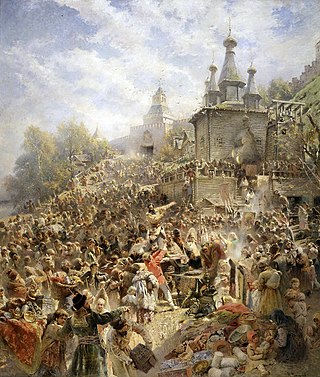
The Time of Troubles, also known as Smuta, was a period of political crisis in Russia which began in 1598 with the death of Feodor I, the last of the House of Rurik, and ended in 1613 with the accession of Michael I of the House of Romanov.
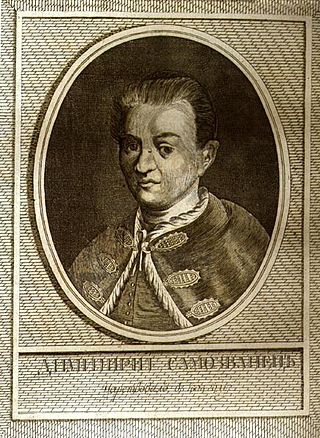
False Dmitry I reigned as the Tsar of all Russia from 10 June 1605 until his death on 17 May 1606 under the name of Dmitriy Ivanovich. According to historian Chester S. L. Dunning, Dmitry was "the only Tsar ever raised to the throne by means of a military campaign and popular uprisings".

Marina Mniszech or Mnishek was a Polish noblewoman who was the tsaritsa of all Russia in May 1606 during the Time of Troubles as the wife of False Dmitry I. Following the death of her husband, she later married another imposter to the throne, False Dmitry II. A devout Catholic, she hoped to convert Russia's population to Catholicism.
Ivan Martynovich Zarutsky was a Cossack leader in Russia in the early 17th century.

Vasili IV Ivanovich Shuisky was Tsar of all Russia from 1606 to 1610, after the murder of False Dmitri I. His rule coincided with the Time of Troubles. He was the only member of House of Shuisky to become tsar and the last member of the Rurikid dynasty to rule as tsar.

False Dmitry II, historically known as Pseudo-Demetrius II and also called tushinsky vor, was the second of three pretenders to the Russian throne who claimed to be Tsarevich Dmitry Ivanovich, the youngest son of Ivan the Terrible, during the Time of Troubles. The real Dmitry had died under uncertain circumstances, most likely an assassination in 1591 at the age of nine at his widowed mother's appanage residence in Uglich.

The Polish–Russian War was a conflict fought between the Polish–Lithuanian Commonwealth and the Tsardom of Russia from 1609 to 1618.
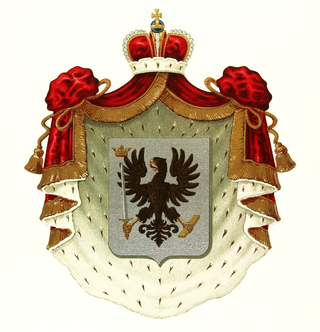
Prokopy Petrovich Lyapunov was a prominent 17th century Russian nobleman (dvoryanin), voivode of, allegedly, a Rurikid origin who practically became a head of Pereyaslavl-Ryazansky lands nobility in the end of 1590s; he took part in wars during power vacuum in succession crisis that happened in early 1598 in Tsardom as result of confusion about legitimate heir apparent following death of Feodor I, nobility infighting, war declared by Polish–Lithuanian Commonwealth (PLC) in 1605, and exhaustive Tatar raids; most famously he is remembered for organizing and leading the first unsuccessful uprising against occupation of Moscow of 1610 by PLC in April of 1611.
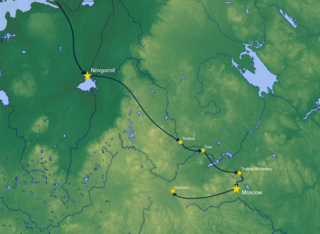
The De la Gardie campaign was a joint military campaign by the Tsardom of Russia and Sweden during the Polish–Russian War from April 1609 to June 1610.
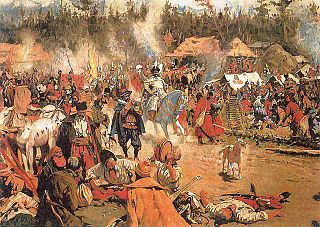
Tushino is a former village and town to the north of Moscow, which has been part of the city's area since 1960. Between 1939 and 1960, Tushino was classed as a separate town. The Skhodnya River flows across the southern part of Tushino.
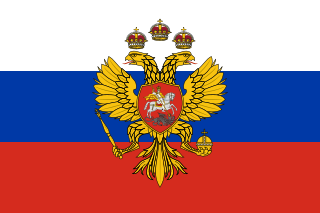
The Tsardom of Russia, also known as the Tsardom of Moscow, was the centralized Russian state from the assumption of the title of tsar by Ivan IV in 1547 until the foundation of the Russian Empire by Peter the Great in 1721.

Xenia Borisovna Godunova (1582–1622) was a Russian Tsarevna, daughter of Tsar Boris Godunov, and sister of Tsar Feodor II of Russia.
Tsarevich Ivan may refer to:

The Battle of Moscow was a series of two battles, which took place in Moscow, on September 1 and 3, 1612, during the Polish–Muscovite War (1605–18), and Time of Troubles. Forces of the Polish–Lithuanian Commonwealth were commanded by Field Hetman of Lithuania, Jan Karol Chodkiewicz, while the Russians were led by Dmitry Pozharsky. Battles ended in decisive Russian victories.

The Uprising of Bolotnikov, in Russian historiography called the Peasant War under the Leadership of Ivan Bolotnikov (Peasant Uprising), was a major peasant, Cossack, and noble uprising of 1606–1607 led by Ivan Bolotnikov and several other leaders. At the time of the highest point of the uprising (the Siege of Moscow in 1606), more than 70 cities in the south and center of Russia were under the control of the rebels.

The Zemsky Sobor of 1613 was a meeting of representatives of the Estates of the realm of the Tsardom of Russia, held for the election of Tsar after the expulsion of the Polish-Lithuanian Occupiers at the end of the Time of Troubles. It was opened on 16 January 1613 in the Assumption Cathedral of the Moscow Kremlin. On 3 March 1613, the Sobor elected Mikhail Romanov as Tsar, establishing the House of Romanov as the new Russian monarchs. The coronation of Michael I is widely considered to be the end of the time of troubles.

Wigund-Jeronym Trubecki or Yuri Nikitich Trubetsky as he was called earlier in Muscovy was the Prince of Trubetsk from 1611 to 1634, preceded by Symeon Iwanowicz Perski Trubecki, succeeded by Piotr Trubecki, and Aleksander Trubecki. Yuri Nikitich Trubetsky was also a boyar and equestrian of False Dmitry II. After emigrating to Poland, and restoring The Principality of Trubetsk, he converted to Catholicism, and took the name Wigund-Jeronym Trubecki.
Godunov is a Russian historical drama television series created by Ilya Tikin and Nikolay Borisov, directed by Alexei Andrianov and Timur Alpatov. The first season premiered from November 5 to November 8, 2018 on the "Russia-1" national TV channel. The second season premiered from March 25 to March 29, 2019.

The Tushino Camp was the camp of False Dmitry II near the village of Tushino near Moscow, which from June 1608 to December 1609 served as the capital of this impostor, who, as a result, received the name "Tushino Thief". All those dissatisfied with the elected Tsar Vasily Shuisky, flocked to the Tushino Camp, which made it a shadow capital with its own state institutions, a patriarch, and so on. From December 1609 to March 1610, the Tushino Camp supported the Polish King Sigismund.

Nicolás de Melo, O.S.A. was a Portuguese Augustinian friar and missionary, whose life was marked by his extensive travels and martyrdom during his mission in Russia. He is recognized for his efforts in diplomatic and religious missions, particularly in Safavid Iran, and is venerated by some as a martyr due to his persecution and eventual death at the hands of anti-Catholic forces.
















